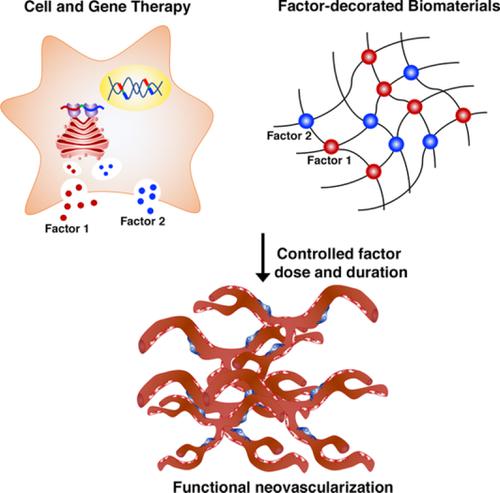当前位置:
X-MOL 学术
›
Stem Cells Transl. Med.
›
论文详情
Our official English website, www.x-mol.net, welcomes your
feedback! (Note: you will need to create a separate account there.)
Therapeutic vascularization in regenerative medicine.
STEM CELLS Translational Medicine ( IF 5.4 ) Pub Date : 2020-01-10 , DOI: 10.1002/sctm.19-0319 Roberto Gianni-Barrera 1 , Nunzia Di Maggio 1 , Ludovic Melly 1, 2 , Maximilian G Burger 1, 3 , Edin Mujagic 1, 4 , Lorenz Gürke 4 , Dirk J Schaefer 3 , Andrea Banfi 1, 3, 4
STEM CELLS Translational Medicine ( IF 5.4 ) Pub Date : 2020-01-10 , DOI: 10.1002/sctm.19-0319 Roberto Gianni-Barrera 1 , Nunzia Di Maggio 1 , Ludovic Melly 1, 2 , Maximilian G Burger 1, 3 , Edin Mujagic 1, 4 , Lorenz Gürke 4 , Dirk J Schaefer 3 , Andrea Banfi 1, 3, 4
Affiliation

|
Therapeutic angiogenesis, that is, the generation of new vessels by delivery of specific factors, is required both for rapid vascularization of tissue‐engineered constructs and to treat ischemic conditions. Vascular endothelial growth factor (VEGF) is the master regulator of angiogenesis. However, uncontrolled expression can lead to aberrant vascular growth and vascular tumors (angiomas). Major challenges to fully exploit VEGF potency for therapy include the need to precisely control in vivo distribution of growth factor dose and duration of expression. In fact, the therapeutic window of VEGF delivery depends on its amount in the microenvironment around each producing cell rather than on the total dose, since VEGF remains tightly bound to extracellular matrix (ECM). On the other hand, short‐term expression of less than about 4 weeks leads to unstable vessels, which promptly regress following cessation of the angiogenic stimulus. Here, we will briefly overview some key aspects of the biology of VEGF and angiogenesis and discuss their therapeutic implications with a particular focus on approaches using gene therapy, genetically modified progenitors, and ECM engineering with recombinant factors. Lastly, we will present recent insights into the mechanisms that regulate vessel stabilization and the switch between normal and aberrant vascular growth after VEGF delivery, to identify novel molecular targets that may improve both safety and efficacy of therapeutic angiogenesis.
中文翻译:

再生医学中的治疗性血管化。
治疗性血管生成,即通过递送特定因子来生成新血管,是组织工程化构建体的快速血管生成和治疗缺血性疾病所必需的。血管内皮生长因子(VEGF)是血管生成的主要调节剂。但是,不受控制的表达会导致异常的血管生长和血管肿瘤(血管瘤)。充分利用VEGF潜力进行治疗的主要挑战包括需要精确控制生长因子剂量和表达持续时间的体内分布。实际上,由于VEGF仍与细胞外基质(ECM)保持紧密结合,因此VEGF的治疗窗口取决于其在每个产生细胞周围的微环境中的量,而不取决于总剂量。另一方面,少于约4周的短期表达会导致血管不稳定,并在停止血管生成刺激后迅速消退。在这里,我们将简要概述VEGF和血管生成生物学的一些关键方面,并讨论它们的治疗意义,尤其着重于使用基因治疗的方法,基因修饰的祖细胞和具有重组因子的ECM工程。最后,我们将提供有关调节血管稳定以及在VEGF输送后正常和异常血管生长之间切换的机制的最新见解,以鉴定可提高治疗性血管生成的安全性和有效性的新型分子靶标。我们将简要概述VEGF和血管生成生物学的一些关键方面,并讨论它们的治疗意义,尤其着重于使用基因疗法,转基因祖细胞和带有重组因子的ECM工程的方法。最后,我们将介绍调节血管稳定以及在VEGF输送后正常和异常血管生长之间切换的机制的最新见解,以鉴定可提高治疗性血管生成的安全性和有效性的新型分子靶标。我们将简要概述VEGF和血管生成生物学的一些关键方面,并讨论它们的治疗意义,尤其着重于使用基因疗法,转基因祖细胞和带有重组因子的ECM工程的方法。最后,我们将介绍调节血管稳定以及在VEGF输送后正常和异常血管生长之间切换的机制的最新见解,以鉴定可提高治疗性血管生成的安全性和有效性的新型分子靶标。
更新日期:2020-01-10
中文翻译:

再生医学中的治疗性血管化。
治疗性血管生成,即通过递送特定因子来生成新血管,是组织工程化构建体的快速血管生成和治疗缺血性疾病所必需的。血管内皮生长因子(VEGF)是血管生成的主要调节剂。但是,不受控制的表达会导致异常的血管生长和血管肿瘤(血管瘤)。充分利用VEGF潜力进行治疗的主要挑战包括需要精确控制生长因子剂量和表达持续时间的体内分布。实际上,由于VEGF仍与细胞外基质(ECM)保持紧密结合,因此VEGF的治疗窗口取决于其在每个产生细胞周围的微环境中的量,而不取决于总剂量。另一方面,少于约4周的短期表达会导致血管不稳定,并在停止血管生成刺激后迅速消退。在这里,我们将简要概述VEGF和血管生成生物学的一些关键方面,并讨论它们的治疗意义,尤其着重于使用基因治疗的方法,基因修饰的祖细胞和具有重组因子的ECM工程。最后,我们将提供有关调节血管稳定以及在VEGF输送后正常和异常血管生长之间切换的机制的最新见解,以鉴定可提高治疗性血管生成的安全性和有效性的新型分子靶标。我们将简要概述VEGF和血管生成生物学的一些关键方面,并讨论它们的治疗意义,尤其着重于使用基因疗法,转基因祖细胞和带有重组因子的ECM工程的方法。最后,我们将介绍调节血管稳定以及在VEGF输送后正常和异常血管生长之间切换的机制的最新见解,以鉴定可提高治疗性血管生成的安全性和有效性的新型分子靶标。我们将简要概述VEGF和血管生成生物学的一些关键方面,并讨论它们的治疗意义,尤其着重于使用基因疗法,转基因祖细胞和带有重组因子的ECM工程的方法。最后,我们将介绍调节血管稳定以及在VEGF输送后正常和异常血管生长之间切换的机制的最新见解,以鉴定可提高治疗性血管生成的安全性和有效性的新型分子靶标。











































 京公网安备 11010802027423号
京公网安备 11010802027423号